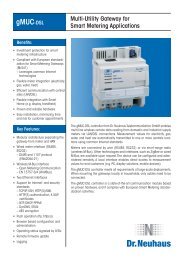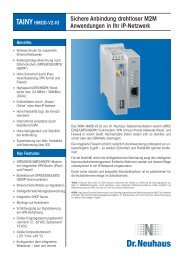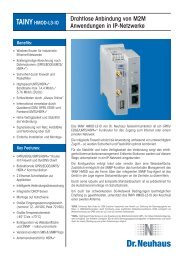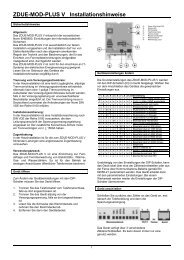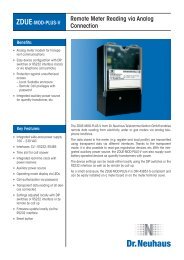tainy hmod-v3-io, tainy hmod-l3-io - Dr. Neuhaus ...
tainy hmod-v3-io, tainy hmod-l3-io - Dr. Neuhaus ...
tainy hmod-v3-io, tainy hmod-l3-io - Dr. Neuhaus ...
Create successful ePaper yourself
Turn your PDF publications into a flip-book with our unique Google optimized e-Paper software.
Small lexicon of routers<br />
DHCP<br />
The Dynamic Host Configurat<strong>io</strong>n Protocol (DHCP) performs automatic<br />
dynamic assignment of IP addresses and other parameters in a network.<br />
The Dynamic Host Configurat<strong>io</strong>n Protocol uses UDP. It was defined in RFC<br />
2131 and was assigned the UDP ports 67 and 68. DHCP uses the client –<br />
server method, in which the client is assigned the IP addresses by the<br />
server.<br />
DNS Addressing in IP networks is always by means of IP addresses. It is generally<br />
preferable, however, to specify the addressing in the form of a domain<br />
address (i.e. in the form www.abc.xyz.de). If the addressing is by means of<br />
the domain address, then the sender first sends the domain address to a<br />
domain name server (DNS) and gets back the associated IP address. Only<br />
then does the sender address its data to this IP address.<br />
DynDNS provider Also Dynamic DNS provider. Every computer that is connected to the<br />
Internet has an IP address (IP = Internet Protocol). An IP address consists of<br />
up to 4 three-digit numbers, with dots separating each of the numbers. If the<br />
computer is online via the telephone line via modem, ISDN or ADSL, then<br />
the Internet service provider dynamically assigns it an IP address, i.e. the<br />
address changes from sess<strong>io</strong>n to sess<strong>io</strong>n. Even if the computer is online for<br />
more than 24 hours without interrupt<strong>io</strong>n (e.g. in the case of a flat rate), the IP<br />
address is changed per<strong>io</strong>dically.<br />
For a local computer to be accessible via the Internet, its address must be<br />
known to the external remote stat<strong>io</strong>n. This is necessary for it to establish a<br />
connect<strong>io</strong>n to the local computer. This is not possible, however, if the<br />
address of the local computer constantly changes. It is possible, however, if<br />
the user of the local computer has an account with a DynamicDNS provider<br />
(DNS = Domain Name Server).<br />
Then he can specify there a hostname under which the computer can be<br />
accessed in the future, e.g.: www.xyz.abc.de. Moreover, the DynamicDNS<br />
provider makes available a small program that has to be installed and<br />
executed on the computer concerned. In each Internet sess<strong>io</strong>n of the local<br />
computer this tool reports to the DynamicDNS provider which IP address the<br />
computer has at the moment. Its domain name server registers the current<br />
hostname - IP address assignment and reports this to other domain name<br />
servers in the Internet.<br />
If now an external computer wants to establish a connect<strong>io</strong>n with a local<br />
computer which is registered with the DynamicDNS provider, the external<br />
computer uses the hostname of the local computer as the address. In this<br />
way a connect<strong>io</strong>n is established with the responsible DNS (Domain Name<br />
Server) in order to look up there the IP address which is currently assigned<br />
to this hostname. The IP address is transmitted back to the external<br />
computer, and then used by it as the destinat<strong>io</strong>n address. This now leads<br />
precisely to the desired local computer.<br />
As a rule, all Internet addresses are based on this method: First a<br />
connect<strong>io</strong>n is established to a DNS in order to determine the IP addresses<br />
assigned to this hostname. Once that has been done, the IP address that<br />
was "looked up" is used to establish the connect<strong>io</strong>n to the desired remote<br />
stat<strong>io</strong>n, which can be any Web site.<br />
EDGE EDGE (= Enhanced Data Rates for GSM Evolut<strong>io</strong>n) refers to a method in<br />
which the available data rates in GSM mobile phone networks are increased<br />
by introducing an addit<strong>io</strong>nal modulat<strong>io</strong>n process. With EDGE, GPRS is<br />
expanded to become EGPRS (Enhanced GPRS), and HSCSD is expanded<br />
to become ECSD.<br />
Page 98 of 111 TAINY xMOD






